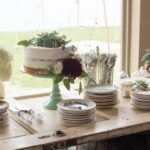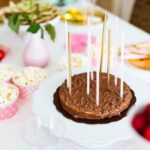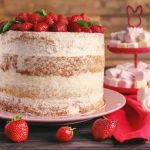Are you looking to learn how to decorate cake easily? Whether you’re a beginner or looking to improve your skills, mastering the art of cake decorating can be a fun and rewarding experience. From essential tools and materials to basic techniques and tips, this article will guide you through the process of creating beautifully decorated cakes with ease.
In the world of baking, cake decoration is a form of art that allows individuals to express their creativity and transform simple desserts into stunning masterpieces. With the right knowledge and practice, anyone can learn how to decorate cakes effortlessly, adding a personal touch to any occasion.
In this comprehensive guide, we will explore the essential tools and materials needed for cake decoration, how to choose the right cake for easy decorating, and preparation techniques such as leveling, crumb coating, and chilling. Additionally, we will provide tips for beginners on basic cake decorating techniques and the use of simple piping techniques to create beautiful designs.
Join us as we delve into the world of cake decorating and discover how you can easily master this art form for impressive results.
Essential Tools and Materials for Cake Decoration
Decorating a cake like a professional does not have to be intimidating, especially if you have the essential tools and materials at your disposal. Here are some must-have items for anyone looking to decorate a cake easily:
1. Turntable: A turntable makes it easy to smoothly rotate the cake as you decorate, allowing for even coverage and precise design.
2. Offset spatula: An offset spatula is perfect for spreading frosting evenly and smoothly on the top and sides of the cake.
3. Piping bags and tips: Invest in a variety of piping tips and bags to create different designs and patterns on your cakes.
4. Bench scraper: Use a bench scraper to achieve smooth, straight sides on your frosted cakes.
5. Cake leveler: A cake leveler ensures that your layers are perfectly even, resulting in a more professional-looking finished product.
6. Food coloring: Stock up on gel food coloring in various colors to customize your frosting and create vibrant designs.
7. Fondant tools (if using fondant): If you plan on using fondant for decoration, make sure to have fondant smoothers, rolling pins, and cutters on hand.
By having these essential tools and materials in your kitchen, cake decorating will become an enjoyable and stress-free experience. With these items, you’ll be well-equipped to create beautiful and professional-looking cakes in no time.
Choosing the Right Cake for Easy Decorating
When it comes to decorating a cake easily, choosing the right type of cake is crucial. Different types of cakes have different textures and levels of moisture, which can significantly impact the ease of decoration. For easy decorating, it is best to choose a cake that is moist but firm enough to hold its shape when layered and frosted.
One popular choice for easy cake decoration is a classic butter or pound cake. These types of cakes have a dense and sturdy crumb, making them ideal for layering and frosting. Another excellent option is a sponge cake, known for its light and airy texture, which makes it easy to work with when adding layers of frosting and decorations.
It’s also essential to consider the flavor and color of the cake when choosing one for decoration. Lighter-colored cakes, such as vanilla or white cakes, provide a blank canvas for colorful frostings and decorations. On the other hand, chocolate cakes can add depth and richness to the overall appearance of the decorated cake.
In summary, choosing the right type of cake is an essential first step in making the cake decorating process easier. A moist yet firm texture, along with considering flavor and color options, will set you up for success in creating beautifully decorated cakes. With the proper choice of cake as your foundation, you are one step closer to mastering the art of easy cake decorating for impressive results.
| Types of Cakes | Recommended for Easy Decorating |
|---|---|
| Butter/Pound Cake | Moist & firm texture ideal for layering and frosting |
| Sponge Cake | Light & airy texture perfect for adding layers of frosting |
| Flavor Consideration | Light-colored cakes provide a blank canvas; chocolate adds richness |
Preparing the Cake for Decoration
Before diving into the actual decorating process, it is crucial to properly prepare the cake. This involves leveling the cake layers to ensure a stable and even surface for decorating. Using a long serrated knife or a cake leveler, carefully trim off any domed tops to create flat, even layers. This step not only creates a more professional-looking finished product but also makes stacking and decorating easier.
After leveling the cake, crumb coating is the next essential step in preparing for decoration. This involves applying a thin layer of frosting to seal in any loose crumbs, preventing them from appearing in the final coat of frosting.
Once crumb-coated, it’s important to chill the cake in the refrigerator for at least 30 minutes before applying the final layer of frosting. Chilling the crumb-coated cake helps solidify the outer layer of frosting, making it easier to add additional decorations without disturbing the base coat.
Properly preparing the cake for decoration sets the foundation for a beautifully decorated finished product. Taking the time to level, crumb coat, and chill the cake will result in easier and more seamless decorating process. These steps are essential for both novice and experienced bakers alike, providing a solid base for creative expression through cake decoration.
| Cake Preparation Step | Importance |
|---|---|
| Leveling | Creates even surface for decorating |
| Crumb Coating | Seals in loose crumbs for smoother finish |
| Chilling | Solidifies outer layer of frosting for easier decorating |
Basic Cake Decorating Techniques and Tips for Beginners
When it comes to decorating cakes, beginners may feel overwhelmed by the daunting task of creating beautiful designs. However, with the right techniques and tips, cake decorating can actually be quite manageable, even for those new to the art. One of the basic cake decorating techniques that beginners can start with is using a simple buttercream frosting to cover the cake. This technique allows for easy smoothing and creates a clean canvas for further decoration.
Another important tip for beginners is to invest in basic cake decorating tools such as offset spatulas, piping bags and tips, and a turntable. These tools not only make the process easier but also help in achieving professional-looking results. Additionally, learning how to properly hold and use these tools can greatly improve the overall outcome of the cake decoration.
For those just starting out in cake decorating, practicing on a small scale can be beneficial. Beginners can begin by decorating cupcakes before moving on to larger cakes. This allows them to hone their skills and gain confidence before taking on more ambitious projects. As with any new skill, patience and practice are key in mastering basic cake decorating techniques as a beginner.
Using Simple Piping Techniques to Create Beautiful Designs
For those looking to step up their cake decorating game, simple piping techniques can be a game changer. With just a few basic tips and some practice, you can create beautiful designs that look impressive and professional. The key to successful piping is having the right tools and mastering some fundamental techniques.
One of the most common piping techniques is creating buttercream flowers. By using different piping tips, you can easily create roses, daisies, sunflowers, and more. Start by practicing on parchment paper before moving on to your cake. It’s important to keep a steady hand and apply even pressure to the piping bag for consistent results.
Another popular technique is creating intricate designs with royal icing. This versatile icing can be used for delicate lace patterns, intricate borders, and detailed lettering. Using a small round tip or a fine writing tip, you can create stunning designs that will impress your friends and family.
If you want to add some dimension and texture to your cake, consider using the star tip for creating rosettes or swirls. This simple yet effective technique adds visual interest to your cakes and cupcakes without requiring advanced skills. Experiment with different colors and piping bag angles to create unique designs that will elevate your baked goods.
Incorporating Edible Decorations for a Professional Touch
Decorating a cake with edible decorations can take your creation to the next level and give it a professional touch. Whether you’re decorating a cake for a special occasion or just for fun, incorporating edible decorations can make your cake stand out. From fresh fruit to chocolate shavings, there are many options for adding edible decorations to your cake.
Choosing the Right Edible Decorations
When it comes to choosing edible decorations for your cake, consider the flavor profile and theme of the cake. Fresh fruit such as berries, kiwi slices, or citrus zest can add a pop of color and freshness to your cake. Alternatively, chocolate curls or shavings can add a touch of elegance and richness to the overall design. Edible flowers such as pansies, violets, or rose petals can also be used to create a beautiful and sophisticated look.
Placement and Design
Once you’ve chosen your edible decorations, it’s important to consider how you will incorporate them into the overall design of the cake. Depending on the size and shape of the cake, you may want to strategically place the edible decorations in a way that creates balance and visual interest.
For example, if you’re using fresh fruit, consider creating a pattern or arrangement that complements the shape of the cake. If you’re using chocolate shavings or curls, think about how they can be used to frame the edges or corners of the cake.
Tips for Using Edible Decorations
When working with edible decorations, it’s important to keep in mind that some items may need to be added just before serving to prevent wilting or melting. Additionally, consider using complementary flavors when choosing edible decorations – for example, pairing strawberries with chocolate or mint leaves with citrus flavors. Finally, don’t be afraid to get creative with your edible decorations. Experiment with different combinations and arrangements to find a look that suits your taste and style.
Incorporating edible decorations into your cake decorating repertoire can add an extra layer of creativity and sophistication to your creations. With careful consideration of flavors, placement, and design, you can easily elevate any cake into a stunning masterpiece that looks as good as it tastes.
Troubleshooting Common Cake Decorating Issues
Uneven Frosting
One common cake decorating issue is getting the frosting to be smooth and even across the entire cake. If you find that your frosting is clumping or tearing the cake, try using a bench scraper or offset spatula to smooth it out. It’s also important to ensure that your cake layers are level before frosting, as uneven layers can lead to an uneven frosting application.
Fondant Cracks or Tears
Working with fondant can be tricky, and one of the most frustrating issues is when the fondant cracks or tears as you’re trying to cover the cake. To avoid this problem, make sure that your fondant is rolled out evenly and doesn’t stick to the rolling surface. If you do encounter cracking or tearing, gently smooth out the fondant with your hands and use a small amount of water to seal any cracks.
Buttercream Melting or Sliding
In warm conditions, buttercream can melt or slide off the sides of a cake, ruining all your hard work. To prevent this issue, make sure that your cake is thoroughly chilled before applying buttercream. You can also adjust the consistency of your buttercream by adding more powdered sugar for stability in warmer temperatures.
By being aware of these common issues and implementing troubleshooting techniques, you’ll have an easier time decorating cakes and achieving professional-looking results.
Conclusion
In conclusion, mastering the art of easy cake decorating can truly elevate your baking skills and impress anyone who sees and tastes your creations. By following the essential tips and techniques outlined in this article, you can achieve professional-looking results with minimal effort. Remember to invest in the necessary tools and materials, choose the right cake for easy decorating, and properly prepare the cake for decoration by leveling, crumb coating, and chilling.
Additionally, utilizing basic cake decorating techniques and simple piping designs will allow you to create beautiful and impressive finished products. Don’t be afraid to experiment with edible decorations to add an extra professional touch. Lastly, familiarize yourself with common troubleshooting issues so that you can address them confidently if they arise during the decorating process.
With dedication and practice, you can become skilled at easy cake decorating and produce stunning results that will be sure to impress your friends, family, or customers. So go ahead, unleash your creativity in the kitchen and make beautifully decorated cakes that taste as good as they look.
Frequently Asked Questions
How to Decorate a Cake for Cheap?
Decorating a cake for cheap can be done by using simple and cost-effective methods such as making your own frosting, using fresh fruits or edible flowers as decorations, or utilizing basic decorating tools like piping bags and tips.
Another option is to focus on simple designs that don’t require expensive ingredients or specialized equipment, such as using powdered sugar stencils or creating a rustic naked cake.
What Are the 3 Tips for Preparing to Decorate a Cake?
When preparing to decorate a cake, it’s important to start with a well-leveled and cooled cake. This will make the decorating process more smooth and seamless.
It’s also helpful to have all the necessary tools and ingredients ready before starting the decorating process, as this will save time and minimize any potential errors during the process. And finally, having a clear idea or vision of the design you want to achieve will help guide your decorating decisions and ensure a cohesive final product.
What Does a Beginner Need for Cake Decorating?
For beginners in cake decorating, some essential items include basic tools such as offset spatulas, piping bags and tips, a turntable for easy frosting application, and a bench scraper for achieving smooth surfaces. Additionally, having a few different types of frosting – like buttercream and fondant – will provide versatility in decorating options.
Basic food coloring gels in primary colors are also helpful for mixing custom shades of frosting for decoration. Finally, starting with simple patterns or designs like polka dots or stripes can be easier for beginners to execute while still achieving an impressive result.

Welcome to my blog about home and family. This blog is a place where I will share my thoughts, ideas, and experiences related to these important topics. I am a stay-at-home mom with two young children. I hope you enjoy reading it! and may find some helpful tips and ideas that will make your home and family life even better!





